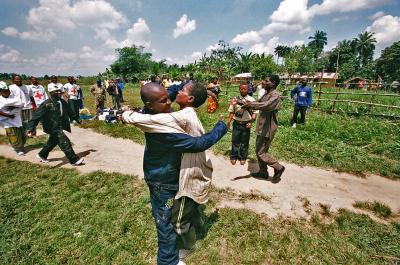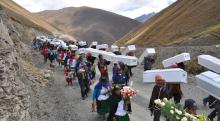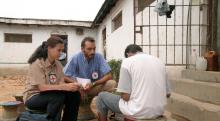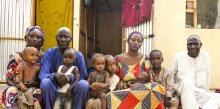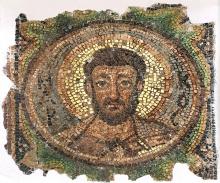Basic international humanitarian law (IHL) rules applicable to this situation:
Children affected by armed conflict are entitled to special respect and protection.
Children must not be recruited into armed forces or armed groups.
Children must not be allowed to take part in hostilities.
The case in brief
From 2001, the Secretary-General of the United Nations (UN) included a list of parties to conflict who recruit and use children in his annual report on children and armed conflict. The DRC had been listed there since 2002.
Influenced by the international norms, domestic and international public opinion, and the political advantages associated with being delisted, the DRC committed to working with the UN to end child recruitment within the Congolese armed and security forces, in compliance with its IHL and human rights law obligations, including the Optional Protocol to the Convention on the Rights of the Child on the Involvement of Children in Armed Conflict. It was delisted in 2017 upon fulfilling the requirements of the plan.
IHL compliance highlights
- In 2012, the DRC signed an Action Plan with the UN to end child recruitment associated with the Congolese armed forces and security services. In 2015, it adopted a Road Map to accelerate the Plan’s implementation.
- The Armed Forces of the Democratic Republic of the Congo (FARDC) fully implemented the Action Plan. Key steps included:
- issuing a military directive prohibiting the recruitment and detention of children, and introducing severe sanctions for breaching these orders
- providing training to FARDC commanders and new recruits to ensure understanding of the FARDC’s commitments under the Action Plan
- improving child protection agencies’ access to military sites and detention facilities to facilitate the identification and release of children
- integrating standard age-verification mechanisms to prevent underage recruitment countrywide
- appointing a Presidential Adviser on Sexual Violence and Child Recruitment
- establishing national and provincial technical working groups, involving representatives from government, the UN and non-governmental organizations, to coordinate implementation across conflict-affected areas.
- In 2017, in recognition of the FARDC’s adherence to the Action Plan, the UN removed the FARDC from its list of state armed forces that recruit and use child soldiers.
Case prepared by Chiara Amitrano, Katrin Busuttil, Li Jian and Beko Wood, students at Roma Tre University, under the supervision of Giulio Bartolini (Associate professor of international law, Director of the Roma Tre University IHL Legal Clinic) and Laura Di Gianfrancesco (PhD candidate).
A. AN ACTION PLAN TO END AND PREVENT THE USE OF CHILD SOLDIERS
[Source: Children and Armed Conflict, “DRC signs Agreement to End Child Recruitment and other Conflict-Related violations against Children”, 4 October 2012, available at https://childrenandarmedconflict.un.org/drc-signs-agreement-to-end-child-recruitment-and-other-conflict-related-violations-against-children/]
The Government of the Democratic Republic of the Congo (DRC) today signed an Action Plan to end the recruitment of children associated with the Congolese armed forces and security services.
“I congratulate the Government of the DRC for the Action Plan it signed today, which is an expression of the Government’s commitment to provide better protection for Congolese children,” the Special Representative of the Secretary-General for Children and Armed Conflict, Ms. Leila Zerrougui said.
The action plan, adopted in the framework of Security Council Resolutions 1612 (2005) and 1882 (2009) was signed by Prime Minister, Mr. Augustin Matata Ponyo Mapon, and the Vice Prime Minister and Minister of Defense, Mr. Alexandre Lubal Tamu, as well as by Mr. Roger Meece, Special Representative of the Secretary-General of the United Nations for the Democratic Republic of the Congo and by the Deputy UNICEF Representative, Mme Sylvie Fouet.
The Action Plan spells out concrete steps for the release and reintegration of children associated with the Government Security Forces, and for the prevention of further recruitment. It has four components:
– access, verification and identification of children in the security forces’ ranks;
– reinsertion and support services for child victims;
– the establishment of accountability mechanisms for perpetrators; and
– the establishment of a collaboration framework for the Government and UN counterparts.
B. FARDC’S PROGRESS IMPLEMENTING THE ACTION PLAN
[Source: Child Soldiers International, “Briefing on the recruitment and use of children in the DRC to the UN Security Council Working Group on Children and Armed Conflict”, 31 July 2014, available at https://www.refworld.org/pdfid/53eb6c8e4.pdf]
[…]
Progress
- Signature, in October 2012, of the Action Plan to end the recruitment and use of children as well as other grave violations against children by the Congolese armed and security forces.
- Subsequent establishment of a Joint technical working group (government – UN – NGOs) to coordinate the implementation of the Action Plan from Kinshasa; creation in June 2014 of the subsidiary Joint technical working group in South Kivu.
- Notable improved access of child protection agencies to military sites and detention facilities for identifying and releasing children, and improved cooperation from military authorities in the screening of armed groups for the same purpose. In the last six months of 2013, this resulted in the separation of 2,894 children from armed forces and armed groups, including 365 girls.
- Start of the dissemination of the Action Plan among members of the armed forces: in March 2013 about 50 FARDC commanders received training on the commitment and objectives of the Action Plan and in April 2013 in Katanga, 3,450 new FARDC recruits received a similar training.
- May 2013 Ministry of Defence directive prohibiting FARDC from, among other abuses, recruiting children and detaining them for association with an armed group, warning that severe disciplinary and penal sanctions will be taken against those who breach the orders.
- May 2013 National Intelligence Agency directive ordering its agents to release any children held for suspected association with armed groups, to transfer them to child protection agencies.
- Appointment of a Presidential Adviser on Sexual Violence and Child Recruitment in July 2014, nine months after the President announced the creation of this post in his speech to the nation.
- A February 2014 amnesty law concerning acts of insurrection, war and political offences committed during the period 18 February 2006 – 20 December 2013 specifically excludes a set of international crimes including child recruitment.
[…]
C. A ROAD MAP BY THE MINISTRY OF DEFENSE
[Source: Children and Armed Conflict, “DRC fact sheet September 2016”, September 2016, available at https://childrenandarmedconflict.un.org/wp-content/uploads/2016/02/DRC-Fact-Sheet-September-2016.pdf]
[…]
A Road map to accelerate the implementation of the Action Plan was adopted in September 2015.
[…]
While new cases of recruitment and use of children by various armed groups are consistently documented by the UN, the national security forces have adopted a policy to ban underage recruitment and are working to fully implement their Action Plan to end and prevent the recruitment and use of children.
[…]
There are ongoing efforts by the Government to hold perpetrators of grave violations accountable. […]
Progress in the implementation of the Action Plan
The Government continues to demonstrate its commitment to fully implement the Action Plan to end the recruitment and use of children by the FARDC, including through the work of the office of Jeanine Mabunda, the Special advisor to the President on sexual violence and child recruitment, appointed in 2014.
In September 2015, the Ministry of Defence endorsed a Road Map identifying key priority activities to address the remaining issues required to fully implement the Action Plan. In addition, the Government is chairing a national joint coordination mechanism and ensuring the decentralization to conflict-affected provinces through the establishment of Provincial Joint Technical Working Groups (-6 have been established so far).
[…]
Strengthening prevention mechanisms and fight against impunity
There is progress in the fight against impunity in DR Congo. Additional support is required to operationalize the road map and to increase the capacity of the judiciary to fight impunity and hold perpetrators accountable. In 2015, the United Nations provided technical support to conduct the screening of over 17,000 troops from the FARDC. However, it will be important for the country to adopt the Standard operating procedures on age assessment, validated at technical level in April 2016, to help the FARDC identify minors countrywide and without assistance. This will help close an important gap to prevent underage recruitment.
Reintegration
Family tracing, reunification and reintegration of children are long-term challenges in DR Congo. With thousands of children in the ranks of armed groups, and hundreds separated each year, resources are needed to provide adequate reintegration services, including psycho-social support, education and vocational training in communities with limited or no services. Cases of re-recruitment are regularly documented by the UN in DR Congo, which indicates the importance of providing sustainable services.
[…]
D. MEASURES TAKEN BY FARDC
[Source: UN General Assembly – UN Security Council, “Children and armed conflict - Report of the Secretary General”, 24 August 2017, available at https://undocs.org/A/72/361]
[…]
Democratic Republic of Congo
[…]
Developments and concerns
71. I commend the Government’s continued and strong commitment to the action plan. While efforts need to be sustained to end and prevent sexual violence by FARDC and to ensure accountability for perpetrators of grave violations, I welcome the significant steps taken to fulfil the provisions of the action plan to end and prevent the recruitment and use of children. This includes the establishment of an additional joint technical working group, the validation of standard operating procedures for age verification, the adoption of a Ministry of Defence directive for the dissemination of those standard operating procedures within FARDC and the screening of new recruits. I am encouraged that, for the second year in a row, no new case of child recruitment and use by FARDC was documented. In terms of accountability, the United Nations documented the arrest of at least 15 FARDC and 5 Congolese National Police officers, including for child recruitment and use of children offences before 2016, while 41 individuals (23 FARDC, 11 Congolese National Police, 1 Mouvement du 23 mars and 6 Nyatura) received sentences ranging from three years of imprisonment to the death penalty for sexual violence against children. The Government indicated that perpetrators of sexual violence against children were sentenced in 129 instances.
72. In July, the Government also endorsed the Safe Schools Declaration. Lastly, the Government provided multisectoral assistance to child victims of recruitment and use and child survivors of sexual violence.
[…]
74. The United Nations provided technical support and screened more than 7,512 members of FARDC, the Congolese National Police, the Direction générale de migration and the Agence nationale de renseignement, and separated 191 children in recruitment centres during the screening of new recruits. Awareness - raising by the United Nations and military pressure also contributed to the separation of 1,662 children from armed groups (177 girls) […].
E. DRC DELISTED FROM THE UN FOR THE RECRUITMENT OF CHILD SOLDIERS
[Source: Media Congo, “ONU: la RDC rayée de la liste des pays recruteurs d’enfants soldats”, 01 November 2017, available at https://www.mediacongo.net/article-actualite-31866_onu_la_rdc_rayee_de_la_liste_des_pays_recruteurs_d_enfants_soldats.html]
The United Nations has removed the Armed Forces of the Democratic Republic of the Congo (FARDC) from its list of state armed forces that recruit and use children as soldiers. The UN secretary-general’s annual report on children and armed conflict, published on 5 October 2017, highlights trends regarding the impact of armed conflict on children and provides information on violations committed in 2016. It listed 56 state forces and armed groups in 14 countries. Prior to 2016, only Chad had managed to meet the requirements for delisting, according to the UN report.
The decision was welcomed by Jeanine Mabunda Lioko, the personal representative of the head of state of the DRC on preventing child recruitment and sexual violence against children. Said Ms Lioko: “This achievement is the result of the determined and concerted efforts made by various governmental bodies, civil society, national and international partners, and, of course, the United Nations.”
The DRC was first listed among the Member States that recruited child soldiers in 1998. Since then, it has adopted various legislative and regulatory measures to address the issue, including, in 2012, an action plan concluded within the framework of UN Security Council Resolutions 1612 (2005) and 2009. At the time, the plan was described as “ambitious” by Leila Zerrougui, the former special representative of the secretary-general for children and armed conflict. The DRC’s successful implementation of the plan contributed to the delisting of the FARDC announced in the UN’s annual report on children and armed conflict.
The current special representative of the secretary-general for children and armed conflict, Virginia Gamba, in an official letter to the government of the DRC, congratulated it for its “involvement in, support for and continued efforts to implement the plan of action, and for having taken all the necessary measures to prevent the FARDC from recruiting and using children”. She also recognized the personal commitment of President Joseph Kabila and of the Office of the Personal Representative as instrumental in the progress made so far in preventing child recruitment and sexual violence against children.
Discussion
I. Classification of the Situation and Applicable Law
1. How would you classify the situation in the Democratic Republic of Congo between 2012 and 2017? Which additional criteria can be used in order to determine such situation? (GC I-IV, Art.3; P II, Art. 1)
II. Protection of Children in Armed Conflict
2. How are children protected by IHL? Does IHL allow the recruitment of children into the armed forces? What is the age threshold used for the recruitment into the armed forces? (P II, Art. 4 (3) (c); CIHL, Rules 135, 136, 137; United Nations Convention on the Rights of the Child of 1989, Art. 38(2) and (3); Optional Protocol on the Convention on the Rights of the Child, on the Involvement of Children in Armed Conflict, Arts. 1-4; ICC Statute, Arts 8(2)(b)(xxvi) and 8(2)(e)(vii))
3. Are the rules protecting children different in IAC and NIAC? Are States and non-State parties similarly bound by the provisions on the prohibition of recruitment and use of children in hostilities? (P I, Art. 77 ; P II, Art. 4(3) , 6(4); CIHL, Rules 135-137)
4. Are children allowed to voluntarily join military forces under IHL? Does IHL distinguish between children who willingly take up weapons and those who are forced to? (P II, Art. 4(3)(c) and (d); ICC Statute, Arts 8(2)(b)(xxvi) and 8(2)(e)(vii))
5. Is there an obligation for States to include the teaching of IHL in military training? Is this obligation applicable even outside armed conflicts? Who else needs to be trained in IHL? (CIHL, Rule 142)
III. Elements Contributing to Respect for IHL
6. (Document A) What was the role of the United Nations in leading the DRC to sign the Action Plan in 2012 and later accompanying the process of implementation? Could have UNICEF played a role in DRC actions to protect children in armed conflicts?
7. (Documents B and C) What concrete measures were required to be adopted by domestic authorities to comply with the Action Plan? What is the role of dissemination campaigns and training against the use of child soldiers? Could the training of soldiers and new recruits give rise in awareness about IHL norms amongst the armed forces?
8. (Document B) How are the directives by the Ministry of Defense and National Intelligence agency effective and significant in enhancing the respect for IHL? How does excluding the crime of child recruitment from the amnesty law indirectly contribute in the generation of greater respect for IHL?
9. (Documents B and D) Why do you think NGOs made their own assessments on the compliance by States of their Action Plan? Can civil society favor the implementation of IHL? What could be the relevance of an advocacy role? Were such NGOs having a direct role in the implementation of the Action Plan?
10. (Documents A, B, and D) Which elements were taken into account in the UN de-listing process? What could be the political advantages for a State to be delisted by the UN?
11. (Documents D and E) Do you think that international and national public opinion can play a role in the State’s action of compliance?

